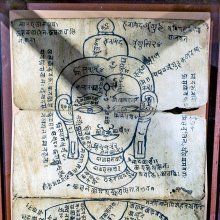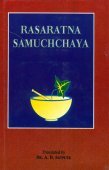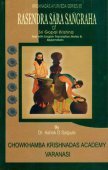Measurement: 3 definitions
Introduction:
Measurement means something in Hinduism, Sanskrit, the history of ancient India. If you want to know the exact meaning, history, etymology or English translation of this term then check out the descriptions on this page. Add your comment or reference to a book if you want to contribute to this summary article.
Images (photo gallery)
In Hinduism
Vastushastra (architecture)
Source: Shodhganga: Elements of Art and Architecture in the Trtiyakhanda of the Visnudharmottarapurana (vastu)The Measurement used in the construction of every part of the Temple is done with hasta i.e., hand. The dimension of the construction of the whole process is basically based on the measurement in terms of hasta. Different parts of Hindu temple are discussed here focusing on the discussion found in the Viṣṇudharmottarapurāṇa.

Vastushastra (वास्तुशास्त्र, vāstuśāstra) refers to the ancient Indian science (shastra) of architecture (vastu), dealing with topics such architecture, sculpture, town-building, fort building and various other constructions. Vastu also deals with the philosophy of the architectural relation with the cosmic universe.
Shilpashastra (iconography)
Source: Shodhganga: Elements of Art and Architecture in the Trtiyakhanda of the Visnudharmottarapurana (shilpa)1) The Measurement (of a portrait) is denoted by the Sanskrit term Pramāṇa, and represents an important topic with which painters must be knowledgeable about, according to the Kāmasūtra and Viṣṇudharmottarapurāṇa, an ancient Sanskrit text which (being encyclopedic in nature) deals with a variety of cultural topics such as arts, architecture, music, grammar and astronomy.—The term pramāṇa is derived from the root mā, which means measurement. In the Mānasāra, pramāṇa is included in the six kinds of measurements. So, it can be said that to draw a picture, the knowledge of proper measurement of a portrait remains very important. The Viṣṇudharmottarapurāṇa also gives emphasis on the proper measurement and structure of a portrait and gives a detailed discussion on the measurement of portrait in the 36th chapter of its third part.
2) Measurement (of every limb of a man as well as of a woman) in ancient Indian Painting (citra) is elaborately and systematically discussed.—In the Viṣṇudharmottarapurāṇa, a specific measurement of every limb of a man as well as of a woman is elaborately and systematically discussed. In this book, the writer has presented the measurement of almost all the body parts that should be maintained in a picture.

Shilpashastra (शिल्पशास्त्र, śilpaśāstra) represents the ancient Indian science (shastra) of creative arts (shilpa) such as sculpture, iconography and painting. Closely related to Vastushastra (architecture), they often share the same literature.
India history and geography
Source: Singhi Jain Series: Ratnaprabha-suri’s Kuvalayamala-katha (history)Measurements refers to a particular quality of a painting, according to the rules of Citrasūtra and the Kathās (narrative poems) such as Uddyotanasūri in his 8th-century Kuvalayamālā (a Prakrit Campū, similar to Kāvya poetry).—Page 233.7: There is a mention of a young painter bringing a cloth-painting on which was depicted the portrait of the daughter of the king of Ujjayinī. The painting was marked with the purity of lines, richness of colours, according to different compositions, beautiful stripling or seedling to show the effect of surroundings or high and low surfaces and right measurements and representation of different lines of painting like sādṛśya. [...]

The history of India traces the identification of countries, villages, towns and other regions of India, as well as mythology, zoology, royal dynasties, rulers, tribes, local festivities and traditions and regional languages. Ancient India enjoyed religious freedom and encourages the path of Dharma, a concept common to Buddhism, Hinduism, and Jainism.
See also (Relevant definitions)
Full-text (+693): Pramana, Parimana, Mana, Unmana, Hasta, Angula, Upamana, Pala, Manopakarana, Pramiti, Pradesha, Valagra, Udhadamapa, Byomtana, Tala, Rastimapa, Matra, Kalamana, Mapa, Byontana.
Relevant text
Search found 147 books and stories containing Measurement; (plurals include: Measurements). You can also click to the full overview containing English textual excerpts. Below are direct links for the most relevant articles:
Vastu-shastra (1): Canons of Architecture (by D. N. Shukla)
(iii) Proportionate measurements (Māna, Aṅgula, Hasta) < [Chapter 6 - Fundamental Canons of Hindu Architecture]
(iv) The Six Canons of Hindu Architecture (Āyādi-ṣaḍvarga) < [Chapter 6 - Fundamental Canons of Hindu Architecture]
(ii) The Architecture (Sthāpatya) < [Chapter 3 - The Architect and Architecture]
Manasara (English translation) (by Prasanna Kumar Acharya)
Chapter 55 - The Jain images (jaina-lakṣaṇa)
Chapter 64 - The comparative measures of images (pratimā)
Chapter 2 - The Qualifications of Architects and the system of Measurement
Nitiprakasika (Critical Analysis) (by S. Anusha)
Sarga IV: Muktāyudha-nirūpaṇa (52 Verses) < [Chapter 2]
Sarga V: Amuktāyudha-nirūpaṇa (51 Verses) < [Chapter 2]
War Weapons (1): Śāstras (Introduction) < [Chapter 3]
Kashyapa Shilpa-shastra (study) (by K. Vidyuta)
4.4. Māna (proportionate measurements) < [Chapter 1 - Introduction]
4. Technicalities (a): Mānāṅgula Measurements < [Chapter 2 - Author and his Works]
2. Kāśyapa Śilpaśāstra (Introduction) < [Chapter 2 - Author and his Works]
Vishnudharmottara Purana (Art and Architecture) (by Bhagyashree Sarma)
7(a): Portrait of Men and Women < [Chapter 5 - Painting and Image Making]
7(g): Role of Eyes in Portrait Created in the Context of Painting < [Chapter 5 - Painting and Image Making]
2. The Importance of the Term Citra < [Chapter 5 - Painting and Image Making]
Matangalila and Hastyayurveda (study) (by Chandrima Das)
Measurement and Age of the Elephants < [Chapter 3]
Avapāta: The fifth technique < [Chapter 3]
Food and Diet of Elephants < [Chapter 3]
Related products
(+2 more products available)






